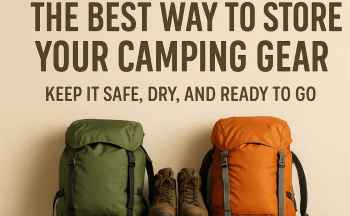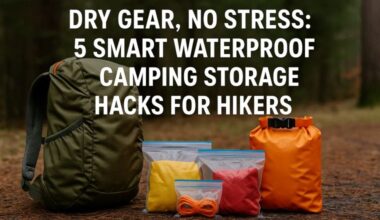Less weight, less waste, more freedom. If you’re tired of lugging around bulky containers and leaving a footprint behind, it’s time to rethink how you pack. Eco-friendly Storage isn’t just possible, it’s practical.
Camping offers a chance to disconnect and enjoy nature. But it also comes with a responsibility to protect the environment. Using sustainable storage practices can help reduce waste and pollution.
When we pack smart and choose eco-friendly gear, we leave less behind and minimize our carbon footprint. As eco-conscious travel grows, so does the need for smarter, greener storage options.
This shift benefits not only the planet but also our mental well-being by fostering a deeper respect for nature.
Choosing Sustainable and Eco-Friendly Storage Options
Lightweight, Recycled, and Repurposed Materials
Recycling and repurposing materials for storage is a small step but makes a big difference. Look for bags, boxes, and containers made from recycled plastics, bamboo, or biodegradable fabrics.
These materials are lighter, which means less fuel is used when towing your gear. Many brands now prioritize sustainability; for example, Patagonia offers gear made from recycled fishing nets. Using such solutions reduces waste and helps cut down energy consumption during production.
Modular and Multi-Use Storage Solutions
Flexibility is key for eco-friendly camping. Modular storage units let you adapt your gear to different needs. Collapsible containers, for example, can serve as bins, coolers, or lightweight luggage.
Multi-use items mean fewer products overall saving space and reducing clutter. Get a sturdy fabric basket that folds flat when not in use but holds camping supplies today and as a laundry hamper tomorrow. This helps cuts down on excess gear and waste.
Eco-Conscious Brands and Certifications
Always look for products with eco-labels like FSC, Green Seal, or OEKO-TEX. These signs show the gear was made with environmental standards in mind. Brands like EcoXGear or BioLite are dedicated to sustainability.
When shopping, verify claims by checking certifications and reading reviews. Choosing certified eco-friendly gear ensures your camping storage minimizes environmental harm and supports responsible manufacturing.
Find more eco-friendly camping gear at our outdoor gear section.
Efficient Packing Techniques to Minimize Waste and Space
Vertical and Layered Packing Strategies
Maximize space with upright stacking and smart organization. Using fabric cubes or adjustable bins helps keep gear in order, making it easier to find what you need. Vertical stacking prevents clutter and minimizes chances of damage.
Think of it like packing a suitcase; keeping items layered makes use of every inch. This method also reduces the need for excess containers, saving space and waste.
Prioritizing Essential and Multi-Functional Items
One of the easiest ways to lighten your load and reduce your environmental impact while camping is to pack only what you truly need. Pack only the essentials, and choose gear with multiple uses.
A multi-tool replaces several devices, and a quick-drying shirt that doubles as a pillow saves space. Experts suggest sticking to camping gear that serves more than one purpose. For example, instead of packing separate pots and bowls, opt for a combined camping cookware set.
Doing this not only helps streamline your packing but also reduces the number of single-use or purpose-specific items you bring into the outdoors. Fewer items mean less gear to store, clean, and eventually dispose of, making your entire camping experience simpler, more sustainable, and more enjoyable.
Eco-Friendly Packaging and Disposal
Say no to single-use plastics. Instead, bring reusable bags, silicone containers, or beeswax wraps for food storage. When packing snacks, opt for compostable wraps. Always plan ahead for waste, bring designated recycling bags, and dispose of waste responsibly.
When possible, leave no trace by recycling or composting on-site. Small habits like these significantly reduce overall trash and waste impact.
Innovative Eco-Friendly Storage Technologies
Solar-Powered and Smart Storage Solutions
Modern tech makes eco-friendly storage items smarter and greener. Solar-powered LED lights can illuminate your gear without batteries. Smart organizers help keep track of essentials with minimal energy.
Some vendors offer solar lanterns that double as phone chargers, reducing the need for extra batteries. These innovations make staying organized easier and eco-friendlier, cutting down on waste and energy use.
Biodegradable and Compostable Storage Accessories
Biodegradable trash bags and compostable containers are game changers. These materials break down naturally and won’t leave lasting waste behind.
Experts see advanced biodegradable plastics as the future for eco-storage solutions.
Proper disposal involves composting or recycling, so check local rules for handling biodegradable materials. By choosing these options, you help reduce landfill contributions.
Biodegradable bags
Switching to eco-friendly storage bags and containers means less plastic in the wild and more peace of mind while you camp.
Space-Saving and Collapsible Storage Options
When space is limited, collapsible storage gear is a game changer. Foldable crates, soft bins, and inflatable organizers help you pack smarter without the bulk.
Foldable crates, inflatable storage bins, and collapsible boxes save space in your car and on-site. These gear options are sturdy enough for daily use but can be folded flat or deflated when not in use.
Using collapsible storage reduces the need for bulky, wasteful containers that sit unused. It means you carry less, waste less, and move more freely on every trip.
Look for durable, eco-friendly storage options designed for frequent packing and unpacking.
Practical Tips for Maintaining an Eco-Friendly Camping Storage System
- Regularly check your gear and recycle or donate items you no longer need.
- Use labels or color-coded systems to extend gear lifespan and reduce waste.
- Keep your storage clean and dry to prevent mold, damage, and unnecessary replacement.
- Encourage your camping crew to adopt sustainable storage habits and share eco-tips.
Conclusion
Choosing eco-friendly storage solutions isn’t just about saving space; it’s about caring for the environment. Smarter packing, multi-use gear, and innovative tech all contribute to a greener camping experience.
When we make these small changes, we protect nature while enjoying our outdoor adventures. Pack light, think green, and your trip and the planet will thank you.
Adopt these eco-friendly storage habits for a more responsible, enjoyable camping experience that leaves only footprints behind.
Want more eco-friendly storage tips? Subscribe to this blog now!




